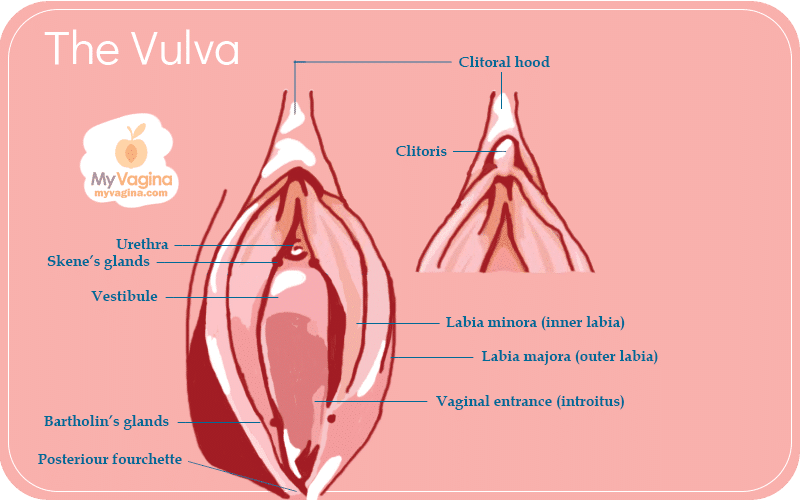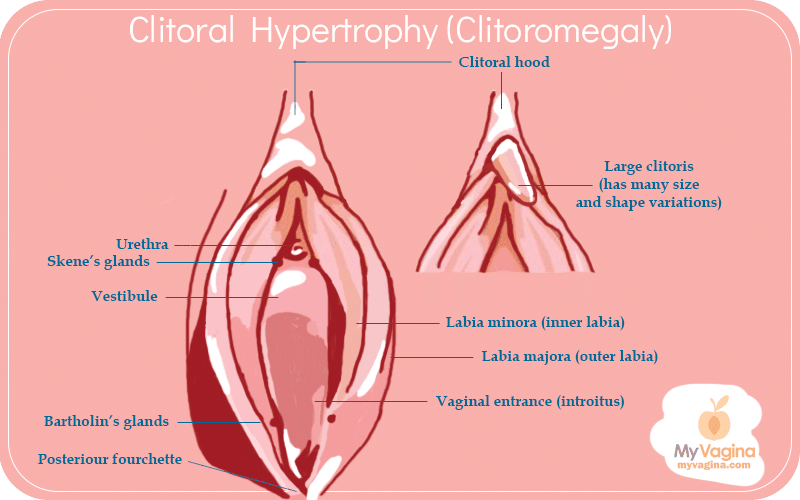Clitoral hypertrophy or clitoromegaly is also known as a macroclitoris: an atypically large clitoris.
Note: This article does not discuss deliberately modified clitorises, such as those found with female genital body modification using anabolic steroids and testosterone.
A typical clitoris looks something like this

The usual size of a clitoris is less than 5mm wide and less than 16mm long, with anything over 35mm indicating clitorial hypertrophy.1
An enlarged clitoris might look like this

There are many variations on clitoromegaly, and everyone will be a bit different.
Clitoromegaly: how does a clitoris get so big?
There are several reasons why a clitoris hypertrophies. Some of the most common include hormonal interruptions caused by chromosomal differences.2 These include:
- Complete, partial or mild androgen insensitivity syndrome (CAIS, PAIS, MAIS)
- Congenital adrenal hyperplasia (CAH)3
- Swyer syndrome
All of these conditions are loosely grouped as a Difference in Sexual Development (DSD). Other reasons for clitoromegaly include certain drugs, tumours, or ‘just because’ (as in, we don’t know).
It is estimated that around one in 10,000 babies has CAH, a major cause of a large clitoris (clitoromegaly).4
Treatment for clitoromegaly
There is usually no medical reason to treat clitoromegaly, however, it can be discussed for aesthetic reasons.5
Some don’t like the look of a large clitoris, and it can be removed (amputated) to completely or partially remove it, with new techniques retaining sexual function and the ability to orgasm in most people.
You have to carefully weigh up the possible risks of a reduction in sexual satisfaction with aesthetics. A clitorectomy usually results in a typical-looking vulva, and satisfaction from the patient, however, while it is generally considered a very safe procedure, it can result in excessive bleeding or worse, permanent nerve damage. 6
Other treatments include hormone therapy, but each person must be evaluated individually since the cause must be established – each treatment for each woman will be different.
The pseudo-penis
A pseudo-penis looks like a penis, but in fact, is not – it is usually a clitoris that looks like a penis. It is a term used to describe the appendage found in many mammals, not just humans, and is understood to be an enlarged clitoris (clitoromegaly).
The pseudo-penis occurs in several other mammals besides humans (the spotted hyena, squirrel monkeys, lemurs and baby fossa, among others).
The penis-like protrusion may disappear as the animal grows, but not always. Other animals (besides humans) that also have elongated labia include the spider monkey, and the os clitoridis (a bone) is found in most mammals.
References
- 1.Fahmy MAB. Female Genital Anomalies, Clitoris. Rare Congenital Genitourinary Anomalies. Published online September 20, 2014:133-144. doi:10.1007/978-3-662-43680-6_8
- 2.Ivanov NV, Serebryakova IP, Khudyakova NV, Fedorova AI. Clitoromegaly: principles of diagnostics and treatment. Akušerstvo, ginekologiâ i reprodukciâ. Published online September 5, 2023:462-475. doi:10.17749/2313-7347/ob.gyn.rep.2023.400
- 3.Szymanski KM, Kokorowski P, Braga LH, Frady H, Whittam B, Hensel DJ. Growing up with clitoromegaly: experiences of North American women with congenital adrenal hyperplasia. Journal of Pediatric Urology. Published online December 2022:775-783. doi:10.1016/j.jpurol.2022.05.016
- 4.Iezzi ML, Lasorella S, Varriale G, Zagaroli L, Ambrosi M, Verrotti A. Clitoromegaly in Childhood and Adolescence: Behind One Clinical Sign, a Clinical Sea. Sex Dev. Published online 2018:163-174. doi:10.1159/000489385
- 5.Stoyanov S, Ivanova K, Koleva I. Operative Treatment of Idiopathic Isolated Clitoromegaly – A Clinical Case. Acta Medica Bulgarica. Published online March 1, 2024:58-61. doi:10.2478/amb-2024-0009
- 6.Kaefer M, Rink RC. Treatment of the Enlarged Clitoris. Front Pediatr. Published online August 28, 2017. doi:10.3389/fped.2017.00125
The most comprehensive vaginal microbiome test you can take at home, brought to you by world-leading vaginal microbiome scientists at Juno Bio.
Unique, comprehensive BV, AV and 'mystery bad vag' treatment guide, one-of-a-kind system, with effective, innovative treatments.
Promote and support a protective vaginal microbiome with tailored probiotic species.





